One participant called it an “eye-opener” — a two-day conference aimed at introducing aliyah shlichim, or emissaries, to Reform Judaism and how the movement views immigration to Israel. But on that score — the priority that Reform Jews place on Israel and aliyah — the event presented a decidedly mixed picture.
Sponsored by the Jewish Agency for Israel, the quasi-governmental agency charged with promoting aliyah, and the Association of Reform Zionists of America, an arm of the Union for Reform Judaism, the Feb. 11-12 event brought together 10 emissaries from cities across North America and 10 regional directors of ARZA.
For the emissaries, the conference represented an opportunity to learn about “the language of Reform Zionism,” said Yoram Black, director of JAFI’s North American delegation. Like most Israelis, he added, the majority of emissaries know little or nothing about Reform Judaism and, therefore, how to promote aliyah among Reform Jews.
For the Reform movement, which hosted the conference at its New York headquarters, the event marked the latest effort in a campaign to boost the number of Reform Jews immigrating to Israel, said Rabbi Andrew Davids, executive director of ARZA. The campaign has also included a drive aimed at bringing 10 Reform families to Modi’in, a growing city between Tel Aviv and Jerusalem, and the recent release of “Faces of Reform Aliyah,” a DVD and booklet with the stories of Reform Jews who have moved to Israel or are considering the move.
Rabbi Davids believes the campaign is beginning to show results, saying that the number of immigrants calling themselves Reform Jews has doubled in the past four years — from 77 in 2003 to 168 in 2007. But the percentage of Reform olim remains miniscule — less than 5 percent of the 3,018 people who made aliyah last year — and stands in marked contrast to the strength of the movement, which, with 1.5 million members, is America’s largest Jewish denomination. The campaign is also seeking to reverse more than a century of Reform history, including decades in which the movement openly rejected Zionism and, later, decades more in which even the word aliyah went unmentioned.
Last week’s conference didn’t overlook the challenges ahead, as suggested by the comments made during one panel discussion, “Israel in the Life of Reform Jews.” Two of the panel’s three members were female rabbis, both of whom have ruled out making aliyah because of Israel’s lack of religious pluralism. “Why, when I can live a full Jewish existence here, would I move to a place that doesn’t recognize me as a rabbi?” asked one of them, as quoted in the Jerusalem Post.
But others were encouraged by what they saw and heard at the conference, which also included Torah study, a prayer session and a visit to the Stephen Wise Free Synagogue.
Neil Gillman, the aliyah shaliach who called the conference an “eye-opener,” is a British oleh who identifies as Modern Orthodox. But he is pleased by the progress he sees in the Reform movement, including the rabbis he encountered who make sure their religious schools emphasize Israel. In working with Reform Jews in the future, Gillman said, his language would include references to tikkun olam and social action — both emphasized during the conference.
The New York Jewish Week brings you the stories behind the headlines, keeping you connected to Jewish life in New York. Help sustain the reporting you trust by donating today.




